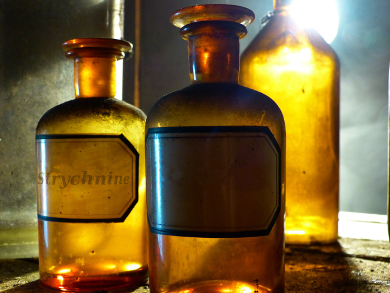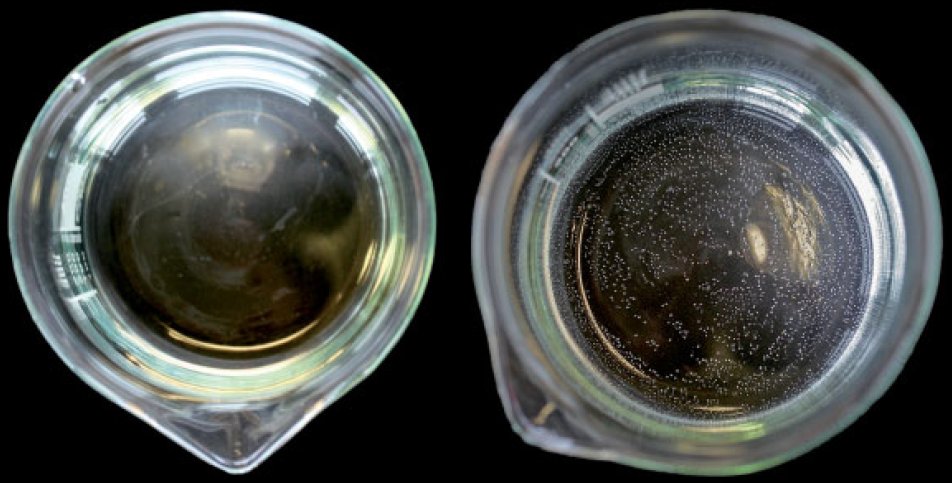The name Agatha Christie (1890 – 1976) occupies a prominent spot on a list of all-time bestsellers: With over two billion (!) copies sold, her works command third place, behind only the Bible and the plays of William Shakespeare. Many of her mystery stories feature a victim who succumbs to the effects of a poison, where cyanide was clearly her favorite. Various unpleasant inorganic compounds of arsenic and thallium also appear once in awhile, and she even resorts to the occasional poisonous alkaloid.
Christie had once worked as a nurse in a hospital pharmacy, so virtually all those things that make a pharmacy interesting but also a bit eerie – digitoxin, cocaine, strychnine, morphine, nicotine, aconite, etc. – find their way somehow into her whodunits.
1. The Mysterious Affair at Styles
In Agatha Christie’s very first crime novel, “The Mysterious Affair at Styles”, published in 1920, Hercule Poirot, her somewhat eccentric, retired Belgian detective, succeeds in solving an insidious poisoning death involving strychnine. Mrs. Inglethorp, wealthy owner of Styles Manor, was discovered in the middle of the night, by family and guests, in a most pitiful state: lying in bed, her entire body wracked with violent seizures. Every now and then the old lady would suddenly go limp, falling back onto the bed, but before long she would again be in the grip of a fresh attack. The spasms were of terrible intensity. All the onlookers crowded in so as to be near her, but there was nothing they could do. One last seizure twisted her body so horribly that only her head and heels still touched the bed. She then relaxed back onto the cushions, never to move again. A preliminary diagnosis by her personal physician, who had rushed to the scene, was later confirmed by a postmortem: oral poisoning from perhaps 65 mg of strychnine.
After another 200 pages of suspenseful text, Poirot succeeds in solving the case, albeit only with help from a pharmacy textbook. Remarkably, the latter in fact described a very similar situation, a tragic misadventure in which a young lady died because the common sleep aid potassium bromide had been added to her tonic, containing the easily soluble strychnine sulfate. The combination was such that the amount of potassium bromide present caused, over time, a considerable quantity of the less soluble strychnine bromide to crystallize out. Colorless crystals of the latter gradually collected, eventually covering the entire bottom of the bottle. Unfortunately, the young woman failed to follow the instructions she received, which called for shaking the bottle before each use. As a result, along with her last dose of tonic she also swallowed all the accumulated strychnine bromide crystals – and promptly died from an overdose.
Paracelsus was the first to observe that “the dose makes the poison”. Indeed, the poison strychnine actually was used – sparingly (!) – as an ingredient in tonics as late as the early 20th century. Sold by the bottle, this home remedy must have tasted terrible, since strychnine is one of the bitterest natural substances known to man. That apparently didn’t contribute to abandonment of the recipe, however. Indeed, extreme bitterness was long taken as a sign of quality!
This tragic mishap served Christie as the basis for her fictional murderer’s devilish plan. Mrs. Inglethorp allegedly picked up from the pharmacist a new bottle of tonic every two weeks, one that was freshly prepared according to her doctor’s prescription (of course without any potassium bromide!). She regularly took a dose just before going to bed. If she had trouble sleeping, she also dissolved a little envelope of sleeping powder (i.e., potassium bromide) in some water, taking that as well. The murderer was very familiar with this routine. The only thing he needed to do was add a few envelopes of potassium bromide directly to a freshly prepared, full bottle of tonic. After a few hours, most of the strychnine would have crystallized out, in the form of the colorless bromide. Critical to the success of the villain’s plan was ensuring that the bottle would never be shaken after he had once prepared it. That way he could be fairly certain that Mrs. Inglethorp would get a lethal dose of strychnine bromide along with the last portion of tonic from the bottle, thanks to the crystals lying on the bottom.
The murderer was also able to predict in advance precisely when this would occur, and thus make sure that, for the appropriate evening, he would have an airtight alibi. The poisoning itself would occur in his absence. Brilliantly planned, because were an autopsy to be conducted, a lethal amount of strychnine would be shown to be present, and a little potassium bromide would raise no suspicions, since it was well known that Mrs. Inglethorp on occasion (and quite voluntarily) took some of this sleep aid. The murder plan was (nearly) perfection itself!
2. Background to the Tragic Strychnine “Accident”
The murderer made one crucial mistake, however: he underestimated Hercule Poirot’s “gray matter”. Not only the murderer knew the background of the tragic strychnine mishap: so did Poirot, because as part of his investigation, he came across the aforementioned pharmacy text. There he found the “recipe” for the tonic, tragically altered with potassium bromide:
- Strychninae Sulph – 1 grain
- Potass Bromide – 6 drams
- Aqua ad – 8 fluid ounces
- Fiat Mistura
After appropriate conversion of the obsolete English pharmaceutical units-of-measure (1 dram = 3 scruples = 60 grains; 1 grain = 64.8 mg; 1 dram = 3.887 g; and 1 fluid ounce = 28.4 mL), the tonic in question turned out to be a mixture of 65 mg strychnine sulfate, 23 g potassium bromide, and 227 mL of water (Fiat Mistura is Latin for “prepare a mixture”) [1].
Strychnine bromide ([StryH+]•[Br–]) only precipitates if the ion product (IP) of the fresh mixture is greater than the solubility product (SP) of strychnine bromide.
For the ion product in the freshly prepared mixture:
|
|
The solubility product is the ion product of a saturated solution. With a solubility of 1 g of strychnine bromide in 50 mL H2O [2], this leads to:
|
|
Clearly, the ion product in the tonic is less than the solubility product, strychnine bromide cannot possibly precipitate out of the tonic!
2.1. Agatha Christie’s Knowledge of Chemistry
So, does Agatha Christie get a failing grade for inadequate knowledge of basic chemistry? We should be careful in passing such a judgment, because the lady was a perfectionist! It is said that if, in the middle of the night, she suddenly had doubts about the way a poisoning was carried out, she would spring out of bed, dash to the nearby hospital, and proceed to discuss her ideas with appropriate experts.
Before we spend too much time pondering over whether basic chemistry or Agatha Christie got it right, let’s mix up a batch of the lethal tonic ourselves, and simply look to see whether or not strychnine bromide precipitates.
|
|
|
Figure 1. Solution of strychnine sulfate in water (left), and the same solution after addition of potassium bromide (right). |
Agatha Christie was right! The solution of strychnine sulfate in water is completely clear, but after addition of potassium bromide, crystals of strychnine bromide precipitate (see Fig. 1). In other words, she knew what she was doing, and it may even be that she had actually checked the situation experimentally.
Regardless of whether she did or not, we need meekly to correct our own oversimplified treatment. Addition of a large amount of potassium bromide in fact reduces the solubility of strychnine bromide (the “salting-out effect”; see below).
2.2. Salting-out Effect
This effect, in the specific case of strychnine bromide, was examined experimentally by I. Simon [3], though not until seven years after the publication of Christie’s book. It was found that the solubility decreased exponentially with addition of bromide ions.
In Agatha Christie’s tonic, 23 g of potassium bromide corresponds to a bromide ion concentration of 0.85 mol/L. According to Simon, at this bromide concentration the saturation concentration for strychnine bromide is only 0.00033 Mol/L. Since the homemade tonic contains a strychnine concentration of 0.00075 mol/L, more than half of it (around 40 mg) could be expected to precipitate.
For a delicately built, elderly lady like Mrs. Inglethorp, this would surely constitute a lethal dose (as was long since clear to Hercule Poirot; for us to be convinced required somewhat more time).
References
[1] R. E. Southward et al., J. Chem. Educ. 1992, 69, 536. DOI: 10.1021/ed069p536
[2] The Merck Index, 9th Ed., Merck, Darmstadt, Germany, 1976.
[3] I. Simon, Arch. Intern. Pharma. Dyn. Therap. 1927, 33, 61.
The article has been published in German in:
- Die tödliche Brechnuss. Strychnin – Von der Isolierung zur Totalsynthese,
Klaus Roth,
Chem. Unserer Zeit 2011, 45, 202–218.
DOI: 10.1002/ciuz.201100552
and was translated by W. E. Russey.
See all articles by Klaus Roth published in ChemViews Magazine
Also of Interest
- Strychnine: From Isolation to Total Synthesis – Part 1,
Klaus Roth,
ChemViews Mag. 2015.
DOI: 10.1002/chemv.201500031
Correction (September 20, 2021)
The article originally misstated the mass of precipitate as 40 g instead of 40 mg.






Great story Klaus. I have a more “popular” quantitative version of the same story in a chapter of “The Last Alchemist in Paris”, ChemistryViews review here: http://www.chemistryviews.org/details/ezine/5915411/The_Last_Alchemist_in_Paris.html
What about strychnine and quinine? I’m reviewing a case involving these two items. Please contact me at (660) 676-7070 if you are willing to discuss!!